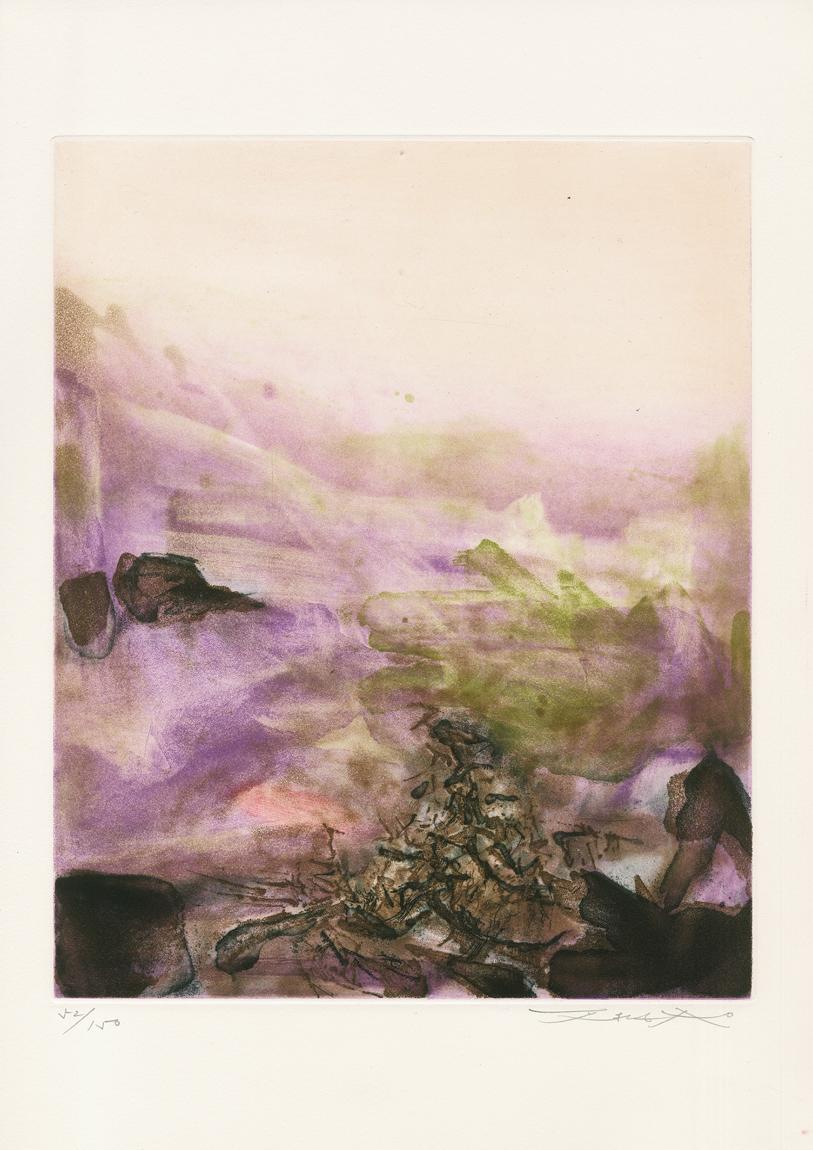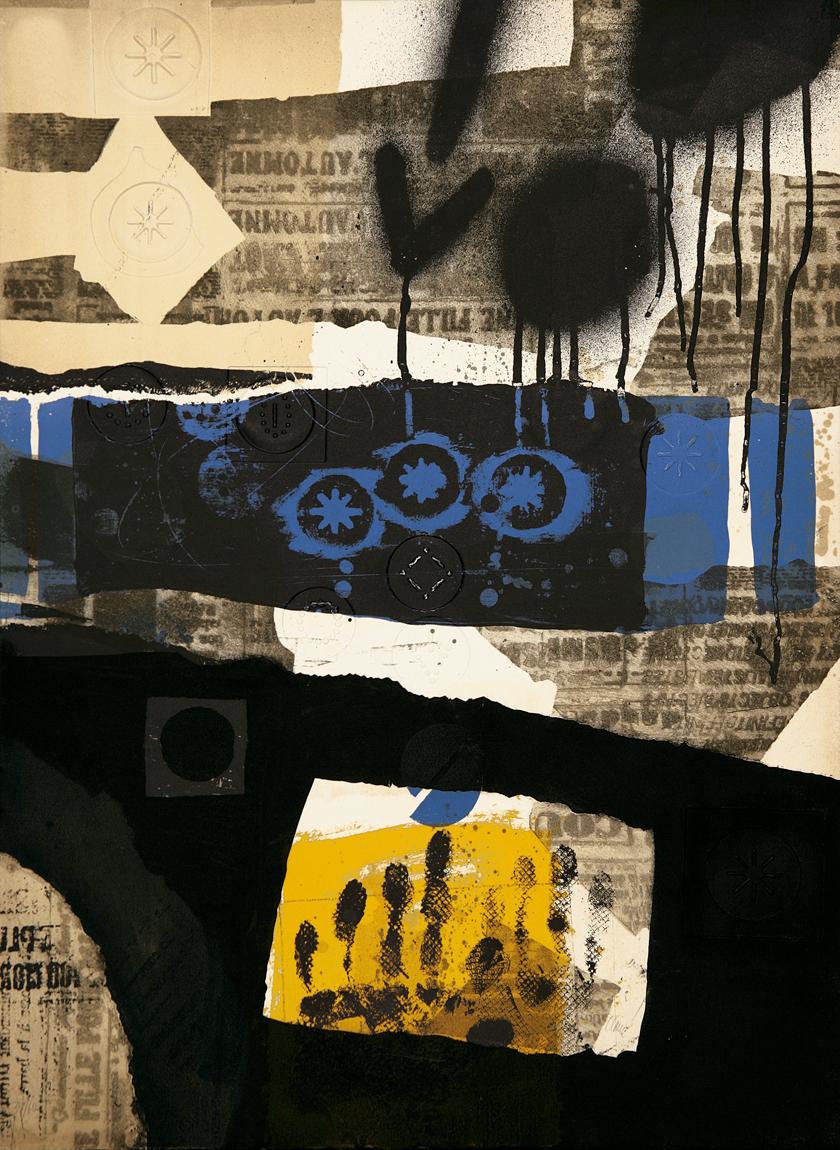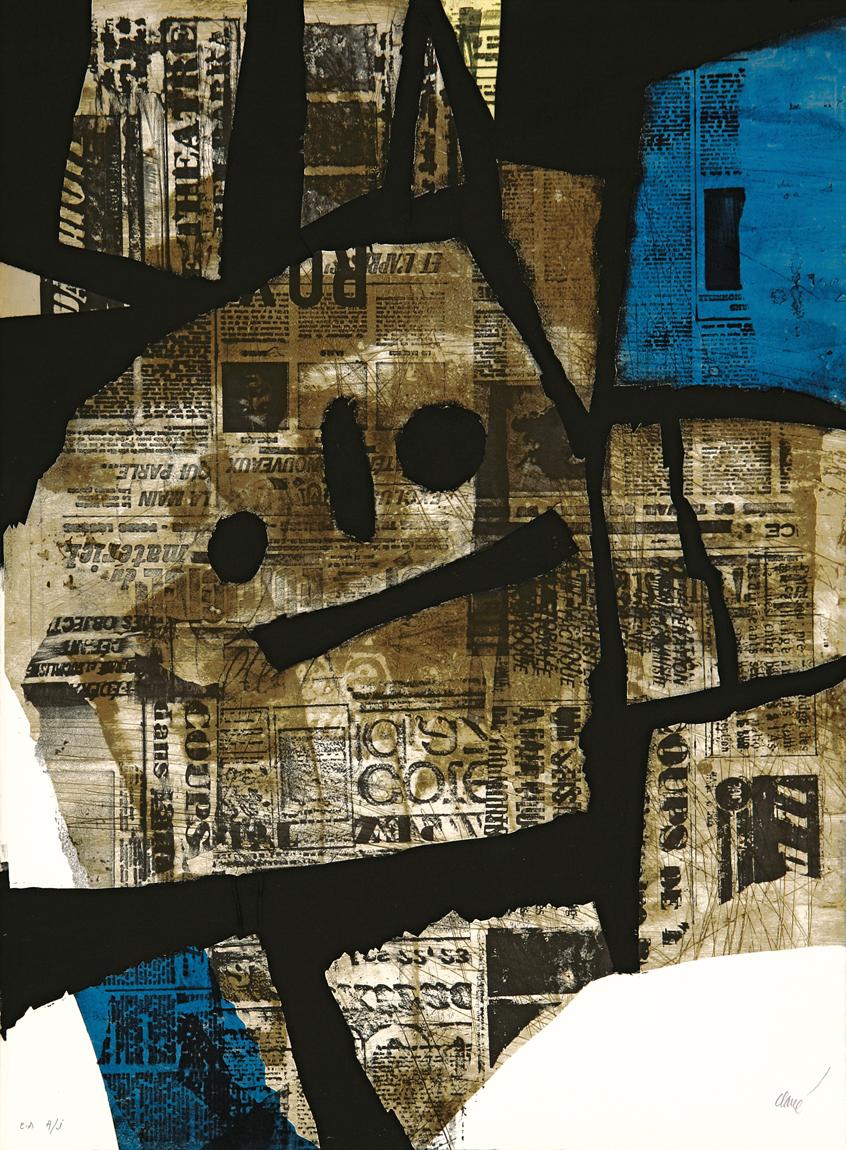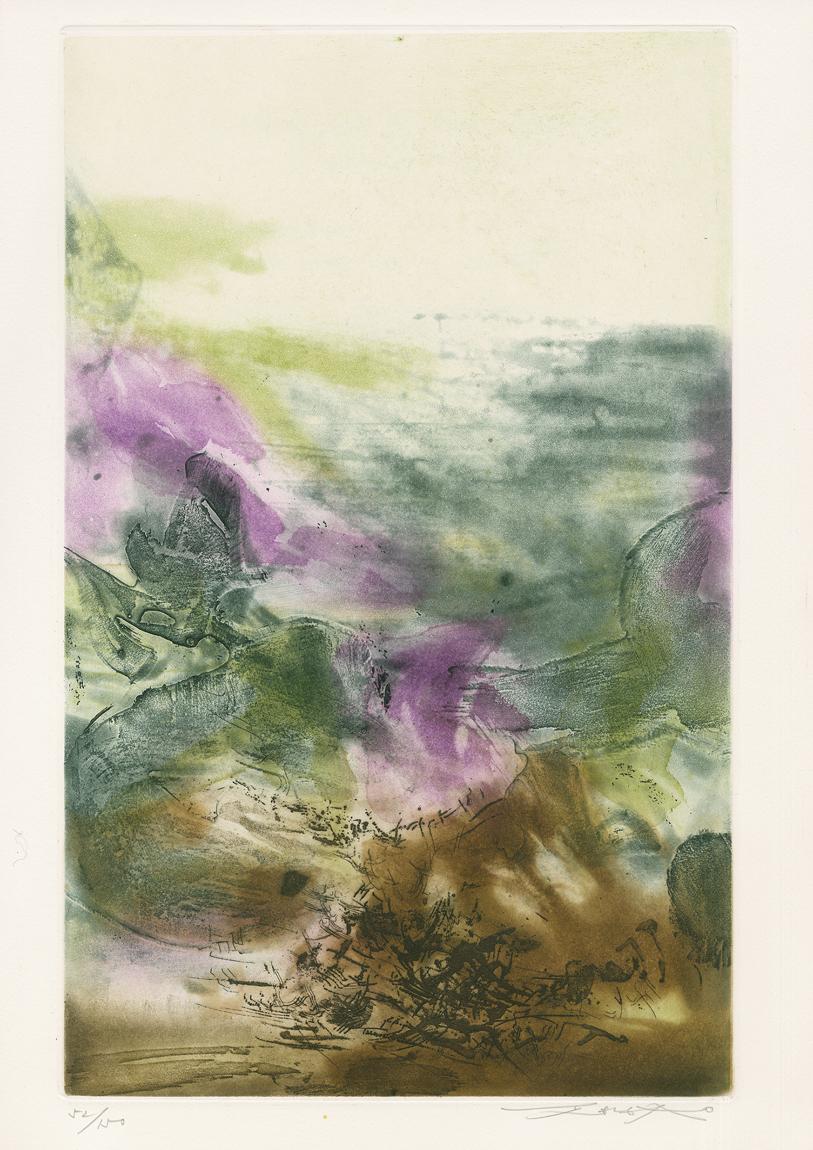Items Similar to Field - Field research -
Want more images or videos?
Request additional images or videos from the seller
1 of 8
Karl MordsteinField - Field research -1983
1983
About the Item
Karl Ludwig Mordstein (1937 Füssen - 2006 Wilszhofen), Field 1983. Color etching, copy 13/65, 22.5 x 28 cm (image), 40 x 45 cm (sheet), 43 x 48 cm (frame), titled, numbered, monogrammed and dated with pencil. Framed behind glass.
- In very good condition.
- Field research -
About the artwork
In accordance with the title, we see a transverse rectangular field that is kept in a brownish tone. However, the field is not an opaque surface, but an inhomogeneous zone of different color intensities with a multitude of individual fluctuating formations. The field is thus not a color surface, but an event space within which something takes place that has been captured here in the stage before our eyes. And the surrounding space of the field is the periphery of the event space, whereby with the hatched zone directly under the field and the gray and brown linear surfaces at the lower edge the ingredients of the field are indicated legend-like.
About the artist
After graduating from the Werkkunstschule in Augsburg, Karl Mordstein worked as a commercial artist in Munich before becoming a freelance artist and concentrating entirely on his own creations. In 1970 Mordstein married the sculptor Sinen Thalheimer and the artist couple moved to Starnberg. In 1972, Mordstein had his first solo exhibition in Munich, which marked the beginning of an active international exhibition career that lasted for decades. From 1987 the couple lived on the Hollerberg in Wilzhofen.
“It is certainly not wrong to recognize in the impression of his calmly floating color drawings the expression of a state of mind that owes itself precisely to this conscious turning away from the hectic art market: concentrated serenity. It is not a changing state of mind, but an empathy with the supra-individual rhythms of creation, the perpetual genesis in the natural cycle of becoming and passing, which is expressed in them.”
- Stefan Tolksdorf
Selected Bibliography
Karl Mordstein. Aquarelle, Gouachen 1972 – 1975, Galerie Angst und Orny, München 1975.
Juliane Roh: Karl Mordstein. Bilder, Paintings 1976 – 79, Frankfurt a. M. 1979.
Siegfried Salzmann (Text): Karl Mordstein. Arbeiten auf Papier, Galerie Dorothea van der Koelen, Mainz 1982.
Galerie Heimeshoff (Hrsg.): Karl Mordstein. "Seelen-Notate"; Bilder, Arbeiten auf Papier, Bildkästen; 1985 – 1988, Essen 1988.
Stefan Tolksdorf (Text): Lebenszeichen. Mordstein, Karl und Sinen Thalheimer, Essen 2009.
GERMAN VERSION
Karl Ludwig Mordstein (1937 Füssen – 2006 Wilszhofen), Feld 1983. Farbradierung, Exemplar 13/65, 22,5 x 28 cm (Darstellung), 40 x 45 cm (Blattgröße), 43 x 48 cm (Rahmen), in Blei betitelt, nummeriert, monogrammiert und datiert. Hinter Glas gerahmt.
- in sehr gutem Erhaltungszustand
- Feldforschung -
zum Kunstwerk
Dem Titel entsprechend sehen wir ein querrechteckiges Feld, das in einem bräunlichen Ton gehalten ist. Das Feld ist jedoch keine opake Fläche, sondern eine inhomogene Zone verschiedener Farbintensitäten mit einer Vielzahl einzelner fluktuierend wirkender Formgebilde. Das Feld ist also keine Farbfläche, sondern ein Ereignisraum, innerhalb dessen sich etwas vollzieht, das hier in dem vor Augen stehenden Stadium festgehalten worden ist. Und der Umraum des Feldes ist die Peripherie des Ereignisraums, wobei mit der schraffierten Zone direkt unter dem Feld und den grauen und brauen linearen Flächen am unteren Rand legendenartig die Ingredienzien des Feldes angezeigt werden.
zum Künstler
Karl Mordstein absolvierte die Werkkunstschule Augsburg und war zunächst in München als Gebrauchsgraphiker tätig, bevor er sich als freier Künstler ganz auf seine eigenen Schöpfungen konzentrierte. 1970 ehelichte Mordstein die Bildhauerin Sinen Thalheimer und das Künstlerpaar zog nach Starnberg. 1972 fand in München eine erste Einzelausstellung seiner Werke statt, die den Auftakt einer über Jahrzehnte währenden regen internationalen Ausstellungstätigkeit markierte. Ab 1987 lebte das Paar auf dem Hollerberg in Wilzhofen.
"Es ist gewiss nicht falsch, in der Anmutung seiner ruhig schwebenden Farbzeichnungen den Ausdruck einer Geisteshaltung zu erkennen, die sich gerade dieser bewussten Abkehr vom hektischen Kunstmarktgeschehen verdankt: konzentrierte Gelassenheit. Nicht wechselnde Befindlichkeit, sondern die Einfühlung in überindividuelle Schöpfungsrhythmen, die immerwährende Genesis im natürlichen Kreislauf von Werden und Vergehen drückt sich darin aus."
- Stefan Tolksdorf
Auswahlbibliographie
Karl Mordstein. Aquarelle, Gouachen 1972 – 1975, Galerie Angst und Orny, München 1975.
Juliane Roh: Karl Mordstein. Bilder, Paintings 1976 – 79, Frankfurt a. M. 1979.
Siegfried Salzmann (Text): Karl Mordstein. Arbeiten auf Papier, Galerie Dorothea van der Koelen, Mainz 1982.
Galerie Heimeshoff (Hrsg.): Karl Mordstein. "Seelen-Notate"; Bilder, Arbeiten auf Papier, Bildkästen; 1985 – 1988, Essen 1988.
Stefan Tolksdorf (Text): Lebenszeichen. Mordstein, Karl und Sinen Thalheimer, Essen 2009.
- Creator:Karl Mordstein (1937 - 2006, German)
- Creation Year:1983
- Dimensions:Height: 15.75 in (40 cm)Width: 17.72 in (45 cm)Depth: 0.79 in (2 cm)
- Medium:
- Movement & Style:
- Period:
- Condition:
- Gallery Location:Berlin, DE
- Reference Number:1stDibs: LU2438212372772

About the Seller
5.0
Vetted Seller
These experienced sellers undergo a comprehensive evaluation by our team of in-house experts.
Established in 2014
1stDibs seller since 2023
7 sales on 1stDibs
Typical response time: 6 hours
- ShippingRetrieving quote...Ships From: Berlin, Germany
- Return PolicyA return for this item may be initiated within 14 days of delivery.
More From This SellerView All
- Memory and Present - The flowing space of memory -Located in Berlin, DEKarl Ludwig Mordstein (1937 Füssen - 2006 Wilszhofen), Memory and Present, 1983. Color etching, copy 41/50, 22.5 x 28 cm (image), 40 x 45 cm (sheet), 43 x 48 cm (frame), titled, numbered, monogrammed and dated with pencil. Framed behind glass. - in very good condition - The flowing space of memory - About the artwork On an implied horizon line, a dog-like animal has risen on its hind legs and is about to jump over some kind of hurdle. To the left, a small flag is waving in the wind. The animal and the flag point forward, toward the reader, into the future. The flagpole, however, bends backwards in the opposite direction, corresponding to the impulse of movement of the sign-like formations in the "sky". The title of this work by Mordstein is also revealing. It reads "Memory and Presence" and thematizes the system of signs above the animal as memory. It is therefore not so much a sky as the space of remembering consciousness. Memory moves into the past, but comes from the future and begins where the animal first moves. Here, Mordstein develops a subtle pictorial philosophy about the character of time and the structure of memory, in which the system of signs representing the content of consciousness is inspired by the pictorial language of Paul Klee, whom Mordstein continues to think about in his own way. About the artist After graduating from the Werkkunstschule in Augsburg, Karl Mordstein worked as a commercial artist in Munich before becoming a freelance artist and concentrating entirely on his own creations. In 1970 Mordstein married the sculptor Sinen Thalheimer and the artist couple moved to Starnberg. In 1972, Mordstein had his first solo exhibition in Munich, which marked the beginning of an active international exhibition career that lasted for decades. From 1987 the couple lived on the Hollerberg in Wilzhofen. "It is certainly not wrong to recognize in the impression of his calmly floating color drawings the expression of a state of mind that owes itself precisely to this conscious turning away from the hectic art market: concentrated serenity. It is not a changing state of mind, but an empathy with the supra-individual rhythms of creation, the perpetual genesis in the natural cycle of becoming and passing, which is expressed in them." - Stefan Tolksdorf Selected Bibliography Karl Mordstein. Aquarelle, Gouachen 1972 – 1975, Galerie Angst und Orny, München 1975. Juliane Roh: Karl Mordstein. Bilder, Paintings 1976 – 79, Frankfurt a. M. 1979. Siegfried Salzmann (Text): Karl Mordstein. Arbeiten auf Papier, Galerie Dorothea van der Koelen, Mainz 1982. Galerie Heimeshoff (Hrsg.): Karl Mordstein. "Seelen-Notate"; Bilder, Arbeiten auf Papier, Bildkästen; 1985 – 1988, Essen 1988. Stefan Tolksdorf (Text): Lebenszeichen. Mordstein, Karl und Sinen Thalheimer, Essen 2009. GERMAN VERSION Karl Ludwig Mordstein (1937 Füssen – 2006 Wilszhofen), Erinnerung und Gegenwart, 1983. Farbradierung, Exemplar 41/50, 22,5 x 28 cm (Darstellung), 40 x 45 cm (Blattgröße), 43 x 48 cm (Rahmen), in Blei betitelt, nummeriert, monogrammiert und datiert. Hinter Glas gerahmt. - in sehr gutem Erhaltungszustand - Der fließende Raum der Erinnerung - zum Kunstwerk Auf einer angedeuteten Horizontlinie hat sich ein hundeartiges Tier auf die Hinterläufe erhoben und setzt zum Sprung an, um eine Art Hürde zu überwinden. Links daneben weht eine kleine Fahne im Wind. Das Tier und die Fahne weisen in Leserichtung nach vorne, in die Zukunft hinein. Die Fahnenstange biegt sich allerdings in die gegenteilige Richtung nach hinten und entspricht damit dem Bewegungsimpuls der zeichenhaften Gebilde am ‚Himmel‘. Auch bei diesem Werk Mordsteins ist der Titel aufschlussreich. Er lautet „Erinnerung u. Gegenwart“ und thematisiert das Zeichensystem über dem Tier als Erinnerung. Daher handelt es sich weniger um einen Himmel als um den Raum des erinnernden Bewusstseins. Die Erinnerung zieht in die Vergangenheit, kommt aber von der Zukunft her und beginnt dort, wohin sich das Tier erst bewegt. Mordstein entwickelt hier eine subtile Bildphilosophie über den Charakter der Zeit und die Struktur der Erinnerung, wobei das für den Bewusstseinsinhalt stehende Zeichensystem von der Bildsprache Plau Klees inspiriert ist, den Mordstein hier auf seine Art...Category
1980s Abstract Abstract Prints
MaterialsEtching
- Indistinct Clear - Fluctuating ambivalence -Located in Berlin, DEKarl Ludwig Mordstein (1937 Füssen - 2006 Wilszhofen), Undeutlicher deutlich, 1982. Color etching, e.a. (Epreuve d'artiste) 4/9, 22.5 x 28 cm (image), 40 x 45 cm (sheet), 43 x 48 cm ...Category
1980s Abstract Abstract Prints
MaterialsEtching
- Aus dem Totenbuch einer Stadt (IV) - The presence of the submerged -Located in Berlin, DEKarl Ludwig Mordstein (1937 Füssen - 2006 Wilszhofen), From the Book of the Dead of a City (IV), 1983. Color etching, copy 16/60, 15.5 x 18.5 cm (imag...Category
1980s Abstract Abstract Prints
MaterialsEtching
- My treasure, my sanctuary / - A Tortured Treasure -Located in Berlin, DEJohannes Heisig (*1953 Leipzig), "My treasure, my sanctuary" - To the Christmas Oratorio by Johann Sebastian Bach. Lithograph on strong yellowish laid paper with watermark, 53 x 39.5...Category
1980s Abstract Expressionist Figurative Prints
MaterialsLithograph
- Threatening to defeat me once and for all / - A Christmas Pietà -Located in Berlin, DEJohannes Heisig (*1953 Leipzig), "Threatening to defeat me once and for all" - To the Christmas Oratorio by Johann Sebastian Bach. Lithograph on strong yellowish laid paper with wate...Category
1980s Abstract Expressionist Figurative Prints
MaterialsLithograph
- Black form surfaces on red painterly ground / - The Double Origin of Painting -Located in Berlin, DEJürgen Möbius (*1939 Großenhain), Black form surfaces on red painterly ground. Oil on hardboard, 50 x 60 cm, 51 x 61 cm (frame), signed "Möbius" and dated "[19]81". - Small paint chip in upper right corner, otherwise good condition. Gallery frame with slight signs of wear. - The Double Origin of Painting - About the artwork In the painting black, optically dominant forms can be seen, which in their arrangement at right angles to each other have a proto-architectural character. They are, so to speak, always already given original forms. At the same time, however, the forms are surfaces of color, and thus genuine painting. In order to make the painterly character of the painting clearly visible, Jürgen Möbius has applied red-toned strokes that have preserved the brushstroke. These are traces of an act of painting. The diagonal layers of red strokes merge into the upper white area, which oscillates between brushwork and homogeneous flatness, while the central white field, into which a black bar protrudes, has a decidedly planar character. The sharp contrast between the autonomous black surface forms, reminiscent of Kasimir Malevich, and the free brushstroke, which is not bound to any motif, creates an enormous pictorial tension, which is conveyed by the white, but at the same time is intensified by the virulent black-and-white contrast. In addition to the tense contrast of form and color, there is also a contrast between the dynamic of the brushstroke and the static of the black surface forms, whereby the diagonal alignment of these forms also gives the static a dynamic, while at the same time the layered brushstrokes have something static about them. Added to this structure of tension is the fact that the painting ground, the unprepared hardboard, is clearly present as such in the picture. In this way, it becomes clear once again that we are not dealing with an autonomous cosmos of form and color, as in Suprematism, but with a painting created by the artist's hand. With this work, Jürgen Möbius explores the possibilities of painting and thematizes painting in terms of its twofold origin, the trace of the guided brush and the painterly form, which gains its independence precisely by absorbing the brushstroke into itself. About the artist From 1959 to 1965 Jürgen Möbius studied painting at the University Institute for Art and Work Education in Mainz. He also studied philosophy and art history at the University of Mainz. Afterwards he worked as a freelance artist in Mainz. At first, Möbius created material reliefs and installations, then, around 1974, he turned increasingly to conceptual art and added cinematic means. During this phase he wrote the manifesto-like essay "Principles of Supranatural Landscape" (1979). From 1981 on, Möbius concentrated on painting and searched for artistic ways to "treat intellectual and sensual perception equally in the fusion of representational and abstract pictorial elements" (Wolfgang Zemter). He found inspiration on his study trips to Thailand and Sri Lanka. "The pure painting of Jürgen Möbius flows through us as a timeless expression of memory and energy, ploughing our perception and bringing us the happiness of seeing authentic, immovable form. - Philippe Büttner Selection of solo exhibitions 1969 Galerie Würzner, Düsseldorf / Galerie Gurlitt, Mainz 1972 Städtische Galerie, Mainz 1973 Galerie Schloss Ringenberg Rathaus, Kleve 1974 Röderhausmuseum, Wuppertal 1976 Galerie Glasing, Osnabrück / Städtische Galerie, Herne 1977, 1997, 2004 Märkisches Museum, Witten 1979 Studio M, Bamberg / Staatstheater, Darmstadt 1980 Galerie Stolànovà, Wiesbaden / Mittelrheinmuseum, Koblenz 1982 Galerie Dornhöfer, Mainz 1984 Galerie Neumühle, Schlangenbad 1985 Landesmuseum, Mainz / Kunstverein, Ludwigshafen / Nassauischer Kunstverein, Wiesbaden 1986 Museum, Bochum / Galerie der Stadt Iserlohn 1987, 1990 Galerie Klaus Kiefer, Essen 1987, 2000 Galerie Ulrike Buschlinger, Wiesbaden 1988 Kunsthalle Darmstadt 1988, 1992, 1996, 1999 Galerie Leonhard, Basel 1992, 2002 Galerie Zulauf, Freisheim 1994 Galerie Remy, Vallendar 1995 Sendezentrum des Zweiten Deutschen Fernsehens, Mainz 2001 Collegium oecumenicum, Bamberg / MVB Forum für Kultur und Wirtschaft, Mainz 2006 Adam Gallery, London Selection of group exhibitions 1969 ‘International Graphic Arts’, Galerie Dalléas Bordeaux, Paris 1975 ‘Deutscher Künstler-Bund’, Dortmund 1979 ‘Man and man’s Images’, Märkisches Museum Witten 1980 ‘Love-Dokuments of our Time’, Art Hall Darmstadt and Art Association Hannover 1982 ‘Work - Progress – Position’, Nassau Art Association Wiesbaden 1983 ‘Principle Hope – Utopic Aspects in Art and Culture of the 20th Century’, Museum Bochum 1986 ‘Selfportraits’, Gallery Klaus Kiefer Essen 1987 ‘The Dying and Death’, Gallery Klaus Kiefer Essen 1989 ‘Where are You, Revolution – Freedom, Liberty, Egality, Fraternity to-day’, Museum Bochum 1990 ‘Flight – a Problem within the Memory of Man’, Kunsthalle Darmstadt ‘Art and War 1939 – 89’, House of Cultures Berlin 1991 ‘Material and Form’, Pillnitz Castle Dresden and Pfalz Gallery Kaiserslautern 1995 20 Years Exhibitions, Chrämerhuus Langenthal, Schweiz 1998 ‘Works on Paper’, Klaus Kiefer Gallery Essen 2000 ‘Acquisitions 1900 – 2000’, Mittelrhein-Museum Koblenz 2001 ‘Strange Pictures’, Klaus Kiefer Gallery Essen 2002 ‘10 Years Buschlinger Gallery’, Buschlinger Gallery Wiesbaden 2004 ‘Eternal Space – Pictures and Sculptures’, Dome of Bamberg 2005 Art Fair Chicago, Adam Gallery, London Selected Bibliography Mittelrheinisches Landesmuseum (Hrsg.): Jürgen Möbius - Neue Bilder, Mainz 1985. Kunstverein Darmstadt (Hrsg.): Jürgen Möbius. Bilder 1985 - 1988. Kunsthalle Darmstadt, 26. Juni - 14. August 1988. Red. Dorit Marhenke, Lyrik Marcus Schiltenwolf, Düsseldorf 1988. Gabriele Prusko (Hrsg.): Jürgen Möbius. Mit Texten von Philippe Büttner und Ralph Mieritz, Basel 1992. Wolfgang Zemter (Hrsg.): Jürgen Möbius - Aktuelle Arbeiten. Märkisches Museum der Stadt Witten, Bönen 1999. Wolfgang Zemter (Hrsg.): Jürgen Möbius. Flieger in meinem Zimmer und Beruhigte Zone, Bönen 2004. Dama Gallery...Category
1980s Abstract Abstract Paintings
MaterialsOil
You May Also Like
- Untitled Sheet 5 from "Canto Pisan" by Zao Wou-Ki, Abstract, Lilac, Black, GreenBy Zao Wou-KiLocated in Köln, DEAquatint in colours by Wou-Ki Zao Untitled Sheet 5 from "Canto Pisan" (portfolio with poems by Ezra Pound), 1972 50,5 x 33 cm Copy 52/150 Edition of 254 ...Category
1970s Abstract Abstract Prints
MaterialsAquatint
- Untitled by Antoni Clavé, Black, Blue, Yellow, AbstractBy Antoni ClavéLocated in Köln, DEColor etching with carborundum by Antoni Clavé "No Title", 1975 75,5 x 55,5 cm Copy 32/60 Edition of 60 (approx.). Antoni Clavé (Barcelona 1913 - 2005 ...Category
1970s Abstract Abstract Prints
MaterialsAquatint, Etching
- Abstract print by Joan Miró from "Fusées" portfolio, blue, black, beigeBy Joan MiróLocated in Köln, DEfrom "Fusées" - Joan Miró, one artwork out of "Fusées" portfolio Wonderful exemplar form the portfolio "Fusées". Aquatint etching from 1959 32 x 50 cm. Edition of 100Category
1950s Abstract Abstract Prints
MaterialsAquatint
- "Ciel" by Antoni Clavé, Blue, Sky, Abstract PrintBy Antoni ClavéLocated in Köln, DEColor etching with carborundum by Antoni Clavé "Ciel", 1971 76,4 x 57,2 cm Copy Artist's Proof Edition 95 copies Antoni Clavé (Barcelona 1913 - 2005 Sai...Category
1970s Abstract Abstract Prints
MaterialsEtching
- "Servando V" by Antoni Clavé, Black, Blue, AbstractBy Antoni ClavéLocated in Köln, DEColor etching with carborundum by Antoni Clavé "Servando V", 1973 66 x 57 cm Copy Artist's Proof Edition of 95 Antoni Clavé (Barcelona 1913 - 2005 Sain...Category
1970s Abstract Abstract Prints
MaterialsAquatint, Etching
- Untitled Sheet 7 from "Canto Pisan" by Zao Wou-Ki, Abstract Print, Lilac, GreenBy Zao Wou-KiLocated in Köln, DEAquatint in colours by Zao Wou-Ki Untitled Sheet 7 from "Canto Pisan" (portfolio with poems by Ezra Pound), 1972 50,5 x 33 cm Copy 52/150 Edition of 254 Zao Wou-Ki (Peking 1921 –...Category
1970s Abstract Abstract Prints
MaterialsAquatint
Recently Viewed
View AllMore Ways To Browse
Marc Koller On Sale
Joe Testa-Secca On Sale
Jorge Camacho On Sale
Jorinde Voigt
Jozsef Shabbat
Junko Mori
Kazuhide Yamazaki Table
Keith Vaughn
Kon Trubkovich
L Cooley
Ladislas Kijno On Sale
Lee Read Jewelers
Leroy Neiman Flag
Lisa Winick
Louis Comfort Tiffany Magnolia
Louis Vuitton Straw Hat
Louisa Chase On Sale
M Wieland





